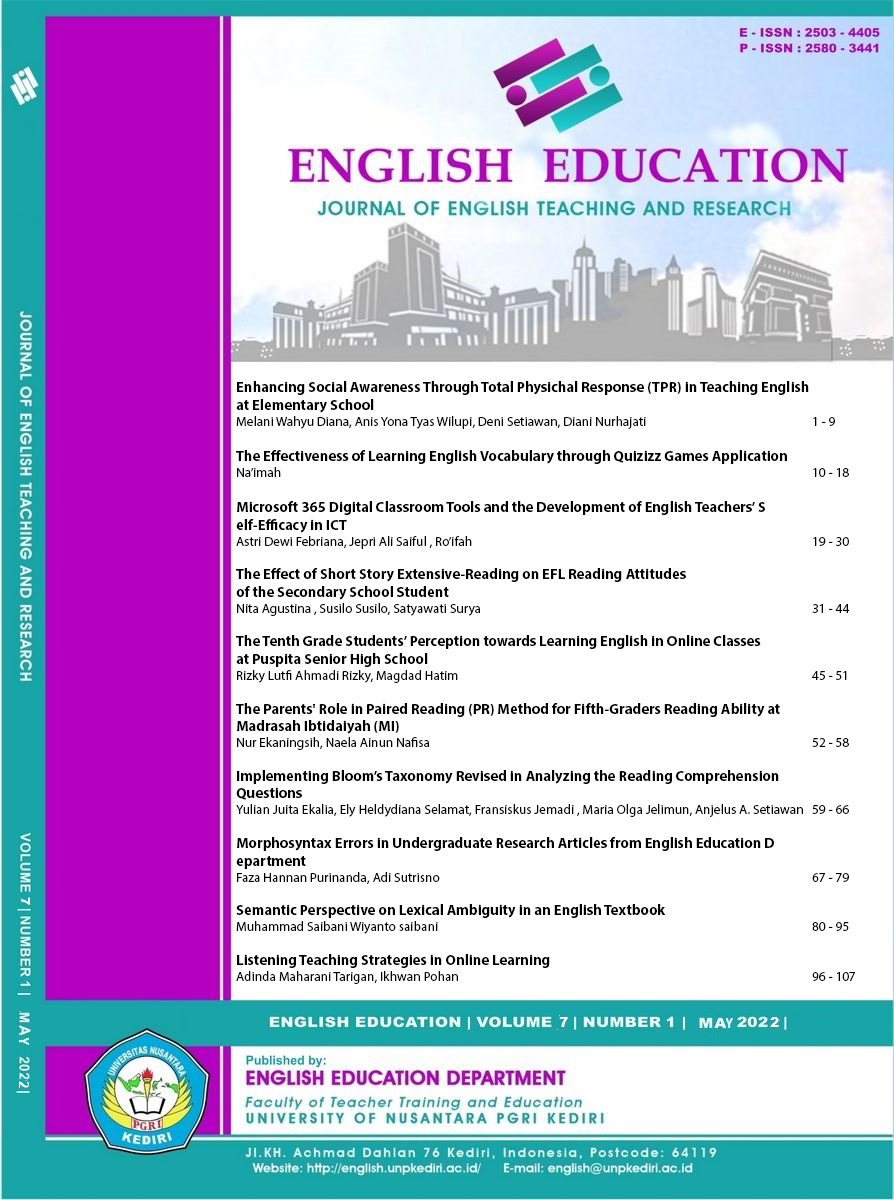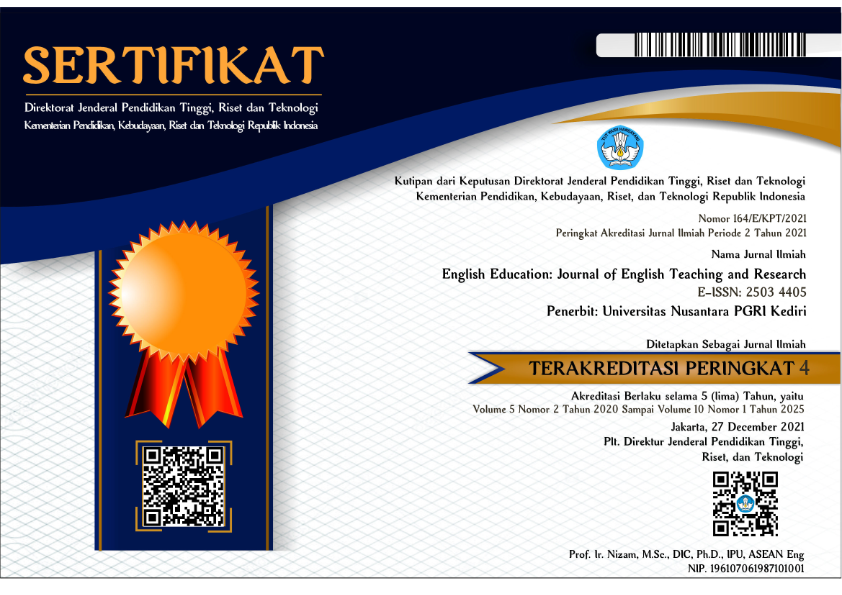The Tenth Grade Students’ Perception towards Learning English in Online Classes at Puspita Senior High School
DOI:
https://doi.org/10.29407/jetar.v7i1.16900Keywords:
Perception, Online Class, English, StudentsAbstract
This study aims to find out the perception of learners about learning English online classes at Puspita Senior High School. The subject of this study consists of two classes namely X IPA 1 consisting of 30 learners and X IPS 1 consisting of 31 learners. This research method uses descriptive qualitative through three data collection techniques, namely 1) observations made during the learning process; 2) questionnaire, given to students to find out the perception of students who have previously been validated by experts; and 3) Interviews, conducted to teachers and principals who are used to support other data. From the data obtained then data analysis was conducted consisting of 1) reduction of data that chooses the core of the data obtained through observation, questionnaire, and interview. After that 2) the presentation of data presented through tables, graphs, and brief descriptions. Then 3) drawing conclusions that answer the formulation of the problem. Based on the results of the study it can be concluded that the majority of learners have a positive perception of online classes. But there are still some learners who experience frustration when online classes are implemented.
Keywords:Analysis, learning difficulties, student perception
Downloads
References
Agistiawati, E., & Asbari, M. (2020). Pengaruh Persepsi Siswa atas Lingkungan Belajar dan Penguasaan Kosa Kata terhadap Kemampuan Berbicara Bahasa Inggris Siswa Sekolah Menengah Atas Swasta Balaraja. EduPsyCouns: Journal of Education, Psychology and Counseling, 2(1), 513-523.
Christian, Y., Robin, R., Aziz, M. F., Kencana, R. T., Exendy, R. R., Triputra, R., ... & Afnesia, U. (2020). Pembelajaran Bahasa Inggris Secara Daring Melalui Youtube. In National Conference for Community Service Project (NaCosPro) (Vol. 2, No. 1, pp. 478-486).
Firmansyah, M. A. (2017). Analisis Hambatan Belajar Mahasiswa Pada Mata Kuliah Statistika. JPPM (Jurnal Penelitian dan Pembelajaran Matematika), 10(2)
Iswari, R, N. (2017). Pengembangan Intrumen Penilaian Berpikir Kreatif Peserta Didik pada Materi Larutan Elektrolit dan Non Elektrolit di Kelas X SMA/MA. Pengembangan Intrumen Penilaian Berpikir Kreatif Peserta Didik pada Materi Larutan Elektrolit dan Non Elektrolit di Kelas X SMA/MA.
Megawati, F. (2016). Kesulitan Mahasiswa Dalam Mencapai Pembelajaran Bahasa Inggris Secara Efektif. Pedagogia: Jurnal pendidikan, 5(2), 147-156.
Mulyani, S. (2020). Students’ Perception and Motivation toward English E-Learning During Covid-19 Pandemic (A Study At The Tenth Graders At Sma N 1 Suruh In The Academic Year Of 2019/2020).
Pujihastuti, I. (2010). Prinsip Penulisan Kuesioner Penelitian. CEFARS: Jurnal Agribisnis dan Pengembangan Wilayah, 2(1), 43-56.
Sari, M. (2016). Blended Learning, Model Pembelajaran Abad ke-21 di Perguruan Tinggi. Ta’dib, 17(2), 126-136.
Sudarsono, A. S., & Suharsono, Y. (2016). Hubungan Persepsi Terhadap kesehatan Dengan Kesadaran (Mindfulness) Menyetor Sampah Anggota Klinik Asuransi Sampah di Indonesia Medika. Jurnal Ilmiah Psikologi Terapan, 4(1), 31-52.
Sugiyono. (2016). Metode Penelitian kuantitatif, Kualitatif, dan R&D. Bandung: Afabeta.
Thomas, D. G., Sompie, S. R., & Sugiarso, B. A. (2018). Virtual Tour Sebagai Media Promosi Interaktif Penginapan Di Kepulauan Bunaken. Jurnal Teknik Informatika, 13(1).
Downloads
Published
Issue
Section
License
Authors who publish with this journal agree to the following terms:
- Copyright on any article is retained by the author(s).
- The author grants the journal, the right of first publication with the work simultaneously licensed under a Creative Commons Attribution License that allows others to share the work with an acknowledgment of the work’s authorship and initial publication in this journal.
- Authors are able to enter into separate, additional contractual arrangements for the non-exclusive distribution of the journal’s published version of the work (e.g., post it to an institutional repository or publish it in a book), with an acknowledgment of its initial publication in this journal.
- Authors are permitted and encouraged to post their work online (e.g., in institutional repositories or on their website) prior to and during the submission process, as it can lead to productive exchanges, as well as earlier and greater citation of published work.
- The article and any associated published material is distributed under the Creative Commons Attribution-ShareAlike 4.0 International License








 Article template
Article template



